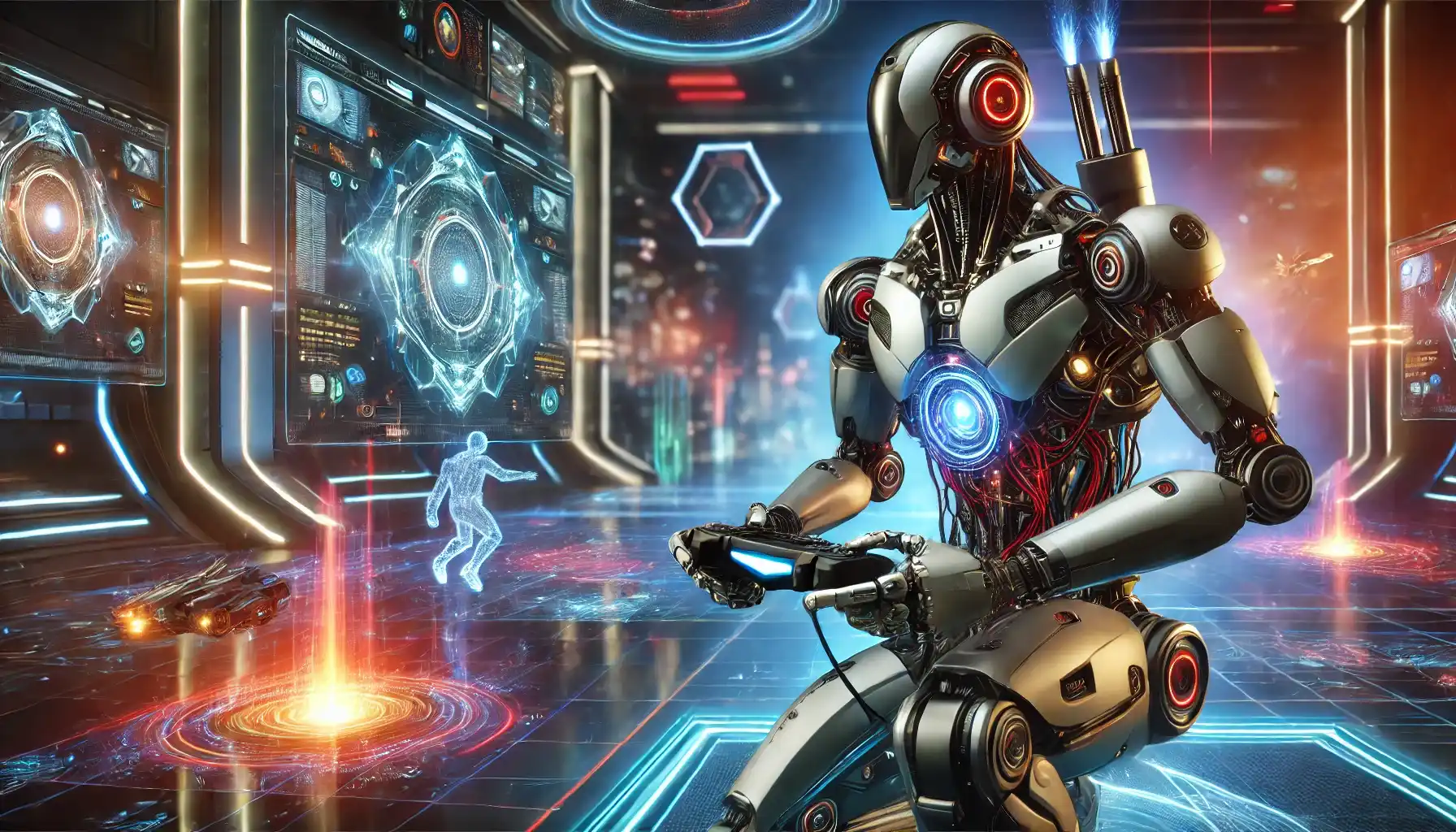In the ever-evolving world of technology, few developments have garnered as much attention and excitement as gaming robots. From the early days of simplistic mechanical toys to today’s advanced AI-driven machines, gaming robots have become an important facet of interactive entertainment. They can entertain, educate, and push the boundaries of what’s possible in digital gaming experiences.
Table of Contents
In this article, we’ll explore the concept of gaming robots, discuss their various applications, and offer some insight into how they continue to reshape the gaming landscape. We’ll also uncover the major benefits and challenges associated with these innovative machines, while examining what the future holds.
The Rise of Gaming Robots
The concept of a “gaming robot” can be interpreted in multiple ways. Some refer to physical robots that are programmed to play games—such as robotic arms beating humans at chess or mechanical contraptions executing rapid-fire button presses on a console controller. Others focus on artificial intelligence (AI) or software “bots” that mimic or surpass human capabilities in video games.
Regardless of form, these robots highlight the impressive strides we’ve made in the fields of robotics, AI, and gaming. As technology evolves, so too does the sophistication of these futuristic machines, paving the way for more immersive and interactive entertainment experiences.
The Early Days of Automated Play
One of the earliest examples of gaming robots includes mechanical devices designed to play simple board games like chess or checkers. These pioneering inventions demonstrated that machines could be programmed to follow a set of rules and even outsmart human players. Over time, innovations in computing power and AI significantly advanced these capabilities, eventually producing game-playing robots that could consistently defeat even the strongest human competitors.
The Convergence of AI and Robotics
Today’s gaming robots fuse robotics hardware with cutting-edge AI algorithms. On the one hand, AI software can analyze mountains of data in mere seconds, generating strategies to beat opponents or solve complex puzzles. On the other hand, physical robots can adapt to real-world environments, manipulating objects to accomplish specific objectives, such as pressing buttons on a controller or moving a chess piece accurately. This powerful combination of software and hardware opens the door to limitless applications in the gaming industry.
Benefits of Gaming Robots
Gaming robots have a wide range of benefits, making them increasingly desirable in both casual and competitive settings. Below are some of the most notable advantages these remarkable machines bring to the table.
1. Educational Opportunities
Robotic systems require knowledge in programming, engineering, and AI—areas that continue to be in high demand. By engaging with gaming robots, users can develop critical skills and gain exposure to future-focused technologies. Schools and universities worldwide have recognized this trend, incorporating robotics in their curricula to encourage problem-solving, collaboration, and creativity among students.
2. Enhanced Training for Players
In competitive gaming, repeated practice is essential for success. Skilled players spend countless hours refining their strategies to maintain a competitive edge. Gaming robots can serve as advanced sparring partners, simulating formidable opponents with perfect precision. These “bot-sparring” sessions can help both professional and amateur players sharpen their skills, identify weaknesses, and refine tactics in a risk-free setting.
3. Accessibility and Inclusivity
Gaming robots can also break down barriers to entry, making certain games more accessible to those who might not otherwise be able to play. Consider people with physical disabilities who might struggle to interact with gaming consoles and controllers in the traditional manner. With assistive robotic tools designed for gaming, these individuals can still enjoy their favorite games using customized inputs and adaptive controllers.
4. Innovations in Gameplay
Finally, gaming robots can introduce entirely new forms of play. From VR-driven robotic companions to real-world interactive devices, these machines can deliver novel experiences that push the boundaries of what we perceive as entertainment. Additionally, gaming robots can be integrated with augmented reality or mixed reality systems to develop even more immersive, engaging, and dynamic gameplay.
Challenges and Concerns
As promising as gaming robots are, there are also potential challenges that demand careful consideration. Addressing these issues responsibly can ensure that robotics and AI technology remain beneficial for users and the gaming community alike.
1. Ethical Implications
Fair Play: The use of AI or software bots in competitive gaming raises ethical questions. When gaming robots outperform human opponents or flood online servers, it can lead to unbalanced, frustrating experiences for human participants.
Automation and Jobs: While automation in general can save time and resources, there is also concern that it may replace certain roles or diminish the need for human input. Balancing the advantages of robotic advancements with the well-being of human employees and content creators remains crucial.
2. Security and Privacy
As with any digital innovation, gaming robots can be susceptible to hacking or manipulation. If a sophisticated gaming bot is compromised, it can pose serious security risks or create unfair advantages in online tournaments. Meanwhile, robotic hardware—especially if it has cameras or microphones—could potentially capture sensitive data, raising privacy concerns.
3. Cost of Implementation
Developing and manufacturing a gaming robot is no simple task. High-quality hardware and advanced AI software are both necessary, making the process expensive and potentially cost-prohibitive for smaller companies or independent developers. This high barrier to entry can limit innovation and keep groundbreaking gaming technologies out of reach for many players.
4. Regulatory and Legal Issues
As with other emerging technologies, gaming robots may be subject to various regulations and restrictions. Depending on the jurisdiction, there may be rules about data collection, AI-driven activities, or mechanical components. Navigating a patchwork of legal frameworks is complex, but necessary to ensure compliance and maintain consumer trust.
Gaming Robots in Different Genres
Gaming robots can be found across a wide variety of genres and platforms, each adding a unique twist to gameplay and interactivity. Below are some prominent examples:
1. Board and Card Games
While AI bots for board games like chess have been around for years, more advanced robotics implementations feature physical robotic arms that move pieces on an actual board. Similarly, card-dealing machines can be enhanced with sensors that track the number and value of cards in play, adding an automated flair to traditional card game nights.
2. Fighting and Action Games
Competitive action and fighting games require fast reflexes and pinpoint accuracy. Gaming robots with high-speed actuators can simulate or even outperform experienced human players. As a training tool, these robots allow aspiring pros to practice advanced combos and perfect their timing without waiting for a human opponent.
3. Puzzle and Strategy Games
Puzzle and strategy games often emphasize planning and forethought. AI-driven gaming robots can swiftly analyze data, predict outcomes, and implement optimal strategies. This presents both a challenge and an educational opportunity for human gamers, who can learn new tactics by studying these advanced robotic methods.
4. Racing Simulators and VR
Racing simulators and virtual reality (VR) games can also benefit from gaming robots. Robotic steering wheels or VR-compatible exoskeletons can mimic the sensation of driving at high speeds or moving through virtual environments. Such innovations heighten immersion, enabling players to feel every twist and turn without actually stepping into a real race car.
The Future of Gaming Robots
The future of gaming robots is incredibly promising, and ongoing developments will likely shape new forms of entertainment, collaboration, and education. Here’s what we can anticipate in the coming years:
1. Greater Integration with AI
As AI continues to evolve, gaming robots will become even smarter. They’ll learn from both successes and failures, improving their performance in real time. Future gaming robots may incorporate advanced deep learning algorithms and neural networks, bridging the gap between human intuition and computational speed.
2. Customized Gaming Experiences
Imagine a future where each player has access to a personalized gaming robot, capable of analyzing that player’s behavior and adjusting gameplay to match their skill level. Such technology could lead to highly specialized experiences that are neither too challenging nor too simple—offering the perfect difficulty curve for players to enjoy.
3. Esports and Professional Tournaments
Gaming robots could soon become integral parts of esports events. While today they serve primarily as training tools or operate behind the scenes, a future scenario might see dedicated robot competitions that captivate global audiences. This could involve robots that autonomously control game characters or perform real-world stunts that tie into digital gameplay, bridging the gap between the physical and virtual domains.
4. Collaboration in Research and Innovation
The complex nature of robotics and AI demands collaboration among a wide range of professionals, including software engineers, hardware designers, game developers, and even psychologists. As research and development in these fields deepen, gaming robots will likely serve as prime testing grounds for new ideas, fostering a collaborative environment that propels innovation across multiple industries.
Conclusion
Gaming robots represent a thrilling intersection of robotics, artificial intelligence, and interactive entertainment. From their humble beginnings as simple mechanical devices to the high-tech AI systems of today, these machines embody both the successes and challenges inherent in pushing technological boundaries. They’re changing how we learn, play, and compete, offering groundbreaking opportunities in education, esports, accessibility, and more.
Yet, as with any rapidly advancing technology, gaming robots must be managed responsibly. Ethical considerations, security concerns, and regulatory frameworks all need to be addressed to ensure fair play, user safety, and consumer trust. Balancing these factors paves the way for sustainable growth and continued innovation in the gaming industry.
The future of gaming robots is bright, with the potential to reshape our understanding of digital competition and interactive experiences. Whether you’re a casual gamer, a professional competitor, or an educator looking to inspire the next generation, there’s little doubt that gaming robots will remain at the forefront of technological and cultural evolution in the years to come.
For more insights into robotics and AI innovations, visit IEEE Spectrum.

